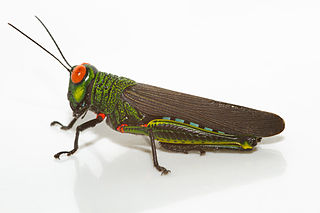Hierodula sternosticta is a species of praying mantis in the family Mantidae.
Alalomantis coxalis is a species of praying mantis in the family Mantidae.
Miomantis coxalis is a species of praying mantis in the family Miomantidae.
Agrilus coxalis is a species of jewel beetle from Guatemala and Mexico, formerly confused with a very similar species from Arizona, Agrilus auroguttatus, which is a significant pest.

Halolaelapidae is a family of mites in the order Mesostigmata.

Halolaelaps is a genus of mites in the family Halolaelapidae. There are about 30 described species in Halolaelaps.
Halolaelaps coxalis is a species of mite in the family Halolaelapidae.

Agrilus auroguttatus is a species of jewel beetle in the United States, known by the common name goldspotted oak borer. It is a woodboring beetle best known for destroying stands of oak trees in the Cleveland National Forest in San Diego County, California, in the United States. It was originally considered a subspecies of the Central American species Agrilus coxalis, and much of the literature refers to it by this name, but now it is regarded as a separate species, known only from Arizona and California.
Copelatus coxalis is a species of diving beetle. It is part of the genus Copelatus in the subfamily Copelatinae of the family Dytiscidae. It was described by Sharp in 1882.
Gnamptogenys coxalis is a species of ant of the subfamily Ectatomminae, which can be found from Borneo, Sri Lanka, India, and Nicobar Islands.
Aleiodes coxalis is a species of parasitoid wasp belonging to the family Braconidae. It was first described by Maximilian Spinola in 1808 as Bracon coxalis. It is found in the Palearctic region.
Pterolophia coxalis is a species of beetle in the family Cerambycidae. It was described by Stephan von Breuning in 1943.

Microbembex is a genus of sand wasps in the family Crabronidae. There are more than 30 described species in Microbembex.

Lyperobius is a weevil genus in the subfamily Molytinae. Most Lyperobius species live in sub-alpine and alpine grassland, feeding on members of the family Apiaceae. Adults are active by day and feed on flowers, seeds, leaves and stems of the host plant. Larvae are found in the thick roots, rhizomes and soil surrounding the root system. All members of this genus are endemic to New Zealand. With the exception of L. huttoni and L. nesidiotes, all species are only found on the South Island.
Neoplasta coxalis is a species of dance flies, in the fly family Empididae.

Proctolabinae is a subfamily of grasshoppers in the family Acrididae. There are more than 20 genera and 210 described species which are found in South America.
Trypanothrips is a genus of thrips in the family Phlaeothripidae.

Serropalpus is a genus of beetles belonging to the family Melandryidae.

Coscineuta is a genus of short-horned grasshoppers in the family Acrididae. There are about eight described species in Coscineuta, found in the Neotropics and South America.

Acroleucus coxalis is a species of seed bug in the family Lygaeidae, found in South America.










